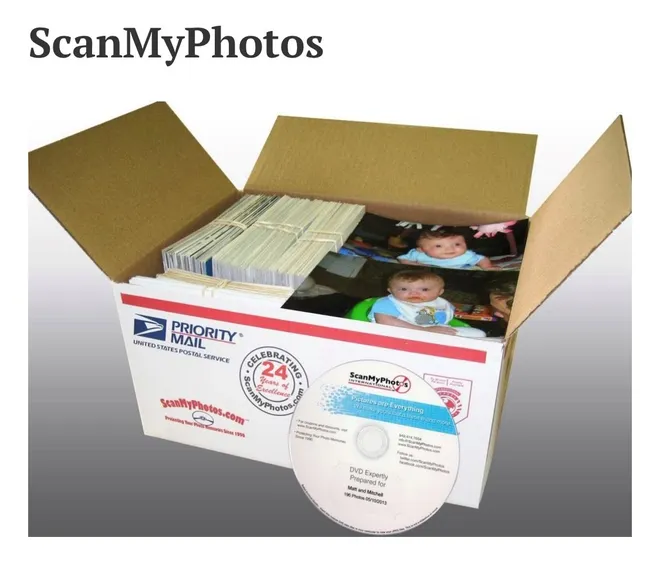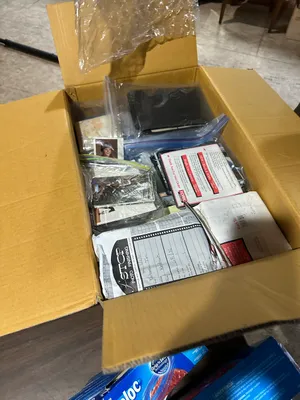Memories tied up in boxes and boxes of pictures? Here's how to scan photos easily
Digitizing old family photos has been on my list of things to do for nearly a decade. But every time I start to collect and organize a lifetime of images — I get so overwhelmed that I jam them back into giant plastic bins labeled “precious family memories” and shove them all back into the closet for another year.
It took the unthinkable — a life-altering family tragedy in November — to finally gather generations of old family photos, slides, film, and videos, tuck them into six giant boxes, and send them to ScanMyPhotos.com.
Then? It took that company less than 48 hours to digitize and return 4,920 photos, 1,435 35mm slides, 1,291 feet of 8mm reels, and 11 VHS tapes.
You read that right. It took ScanMyPhotos less than two days to do what I had been trying to accomplish for ten years. The total cost? Less than $1,000. But for me and my family, the results are absolutely priceless.
In a world filled with tech companies promising to change our lives in myriad ways sure to “surprise” and “delight,” this one company provided the single most meaningful service I’ve experienced to date.
I’ll get to the whole story in a second, but first, here’s the lowdown on prices for this specific service. I’ve tried many others throughout the years, but this was the least expensive and easiest overall:
- Prepaid Photo Scanning Box: Each box can accommodate approximately 1,800 standard photographs. The company says this is an estimate, and the actual number may vary based on how you pack and the photo sizes. You can enhance your order by selecting the highest resolution size (600 DPI) for the highest quality archives.
- Prepaid Slide Box: This box can hold around 540 standard 35mm slides, which the company scans at 2,000 DPI and delivers as JPEG files. The team professionally hand scans and corrects each slide to ensure the best results. The newest service is for full slide carousel scanning (up to 140 slides) at $59.95, digitized at 4,000 DPI.
- Prepaid VHS Transfer Box: You can send up to 14 tapes, including VHS, VHS-C, or Hi8 tapes, or any combination of these formats in the box. Each tape gets transferred to its own DVD or uploaded to a cloud service such as WeTransfer for you to watch on your own TV or screen.

When tragedy strikes, photo memories can help and heal.
I grew up in a tight-knit family in a rural area of Alaska’s Kenai Peninsula. My grandparents lived across the street. One set of aunts and uncles lived next door; another pair lived nearby.
It was an idyllic childhood in so many ways, and after 30 years of living and working in other states, my husband and I packed up our lives in the San Francisco Bay Area and moved to Whidbey Island in the Puget Sound, about an hour outside of Seattle in early 2022. Our goal is to recreate that close-knit community I grew up in, for the next generation.
We moved next door to one of the aunts and uncles I grew up with and moved my parents in with us for half of the year. (They still spend summers in their home in Alaska but fly south to the island every winter.) My cousin and his family moved nearby last year too.
And just like that, we’re back to having dinner together several nights a week, similar to my childhood. My uncle taught my city-slicker husband how to use a chainsaw, and we all work alongside each other on their farm and timber land — mucking stalls, planting trees — and doing other daily chores to keep up with their 80-acres and our 10. It feels like old times — but renewed for the next generation — and it’s been magical.
Until November 8th. My uncle was killed in a heavy equipment accident on their farm next door to us. He died instantly. My aunt found him, and my husband and I arrived minutes later.
As a reporter, I’ve witnessed horrible tragedy countless times before, and kept my cool amid unimaginable shock, anguish, and grief. While that experience helped me navigate dozens of details in the following days and weeks after my uncle's death, one of the most significant — and healing — was getting all those images scanned.
I made three videos for his memorial service, several photo books, and a handful of other precious keepsakes to celebrate and remember his remarkable life and impact on everyone who knew him.
I cannot express how meaningful that was — is — and how healing too.
Here’s how to do it yourself.
One of the biggest takeaways is — don’t wait until disaster strikes to do it yourself. Also? Don’t overthink it.
The most overwhelming part — and the part most people get stuck on — is gathering and organizing years of printed photos and old slides. The best thing to do is remove them from albums if you can, then make stacks of ones that make sense together.
Mitch Goldstone, the CEO and co-founder of ScanMyPhotos, recommends using rubber bands and sticky notes to identify the various stacks of photos.
I sorted them into large Ziplock bags and labeled each one with a Sharpie. Once I let go of everything having to be perfect, the entire process took less than an hour. They get scanned in the order that you send them in, so if you have time to sort and label them, that’s great, but don’t let that stop you from just getting it done in the first place.
Send slides the same way or even in a carousel. The same goes for all old film and VHS tapes. I highly recommend adding image rotation and a photo index book to your order. The photo index book has every image scanned with a corresponding number, making it easier to locate and edit them into slide shows and movies later.
The company sent us all the uploaded files via WeTransfer and on a thumb drive too. They also returned all the originals.
Once I got all that back, I wasted a few days trying to find an AI service to group the shots by events, dates, people, locations, etc. I tried Tonfotos and Mylio but was on such a tight deadline for the memorial service that I gave up and used sticky notes with the photo image book instead.
I’ll keep working on that AI part because it seems like it should exist for general consumers, but I have yet to find it.
From there, I fired up iMovie on my Mac, which is dead simple, and then dragged and dropped the photos and videos into the timeline.
I searched my uncle’s most-played songs on his iPhone to choose the right music to play along with old photos and videos. I ran into another snag, though, because you can’t just download a bunch of music to your device without copyright issues.
For this, I found another quick workaround. I found the songs on YouTube, then used an app called Clipgrab to download them as MP3s to my desktop. If I were a real pro, I would have used Final Cut or Premiere and could have finessed it all a bit more, but as-is, the movies were magical and meaningful — just right to memorialize a remarkable life.
I also uploaded several hundred images to an Aura digital photo frame and gave one to my aunt and cousin right after the service. Finally, I used a service called Mixbook to create several albums for other family members.

The time is now
As storms and record cold ravage the country, and at a time of year when we have a moment to catch our breath and dig out of the holiday madness, I cannot recommend any single service more than this one. Stuff comes and goes, but for the brief time we are intensely together in this lifetime, our memories can be the most sacred gift of all. Finding such a profound way to relive and share them now — and for generations to come — can make all the difference in the world.
Jennifer Jolly is an Emmy Award-winning consumer tech columnist and on-air correspondent. The views and opinions expressed in this column are the author's and do not necessarily reflect those of USA TODAY. Contact her atJJ@Techish.com.
Disclaimer: The copyright of this article belongs to the original author. Reposting this article is solely for the purpose of information dissemination and does not constitute any investment advice. If there is any infringement, please contact us immediately. We will make corrections or deletions as necessary. Thank you.






